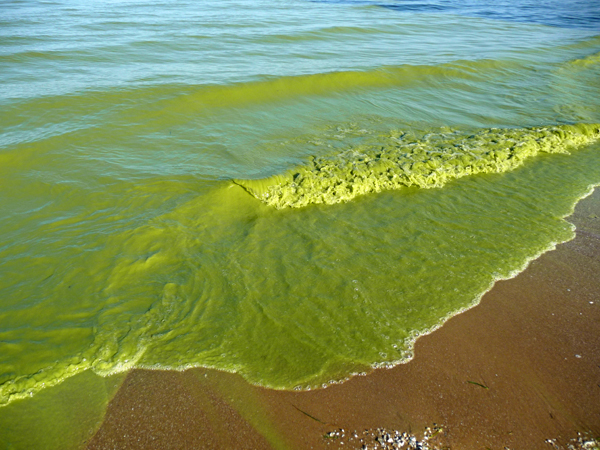18
Apr
Climate Change Augments Agricultural Chemical Impacts on Lake Erie
(Beyond Pesticides, April 18, 2013) With hotter and more frequent extreme weather events, scientists say harmful algal blooms caused by pesticides and fertilizer inputs will strike more often in water bodies like Lake Erie, to the detriment of aquatic life and surrounding wildlife. All trends, show that the conditions that caused Lake Erie’s 2011 algal blooms will continue recurring. The algal blooms, which cause bright green scum that completely covers the Western part of Lake Erie, occurs from mid-July to October, in part because of farming practices surrounding the Lake and in part due to climate change.
Ecologist Thomas Bridgeman, Ph.D. at the University of Toledo contributed to these findings in this month’s  publication of the Proceedings of the National Academy of Science entitled “Record-setting algal blooms in Lake Erie caused by meteorological trends consistent with expected future conditions. “The 2011 bloom was a catastrophe. But it could become the new normal if we don’t do anything” said Dr. Bridgeman.
publication of the Proceedings of the National Academy of Science entitled “Record-setting algal blooms in Lake Erie caused by meteorological trends consistent with expected future conditions. “The 2011 bloom was a catastrophe. But it could become the new normal if we don’t do anything” said Dr. Bridgeman.
Importantly, the study concludes that “long-term trends in agricultural practices are consistent with increasing phosphorus loading to the western basin of the lake, and that these trends, coupled with meteorological conditions in spring 2011, produced record-breaking nutrient loads.” In short, Lake Erie’s algal problems are caused by agricultural practices, particularly fertilizer use, which provided nutrients for the blooms to grow. This is compounded by warmer weather, which allows the cyanobacteria, or blue-green algae, to grow and multiply, causing toxic effects.
For example, the species of cyanobacteria Microcycstis produces a liver poison that is toxic to aquatic organisms. While humans are unlikely to drink the water, fish and zooplankton do eat the cyanobacteria, harming their liver and nervous system. Those animals that eat or inhale the off-gas, like nearby shorebirds, are also at risk: “When it gets into the respiratory system, it’s incredibly toxic,” says marine biologist Michael Carvan, Ph.D. at the University of Wisconsin.
Not only are these blooms toxic, they are also a sink for dissolved oxygen, causing so-called dead zones. Scientists say that the water chemistry of dead zones may also cause sediments that release yet more toxins, such as mercury, that they store in cool, oxygenated waters. While at the same time, the dead zones may store phosphorous and other nutrients in the lake that are recirculated during storms.
The results of the study have implications not just for long term management of Lake Erie itself, but also for farms alongside the lake that are a source of these algal-bloom causing nutrients. The study indicates that, “Three management practices ””autumn fertilizer application, fertilizer being broadcast on the surface rather than injected in the soil, and conservation tillage”” can create conditions for enhanced [phosphorous] runoff.”
While farming will no doubt continue around Lake Erie, so too will climate change. Ecologist and contributor Anna Michalak, Ph.D. at the Carnegie Institution for Science urges the adoption of prudent farming practices that could save farmers money while simultaneously reducing nutrient loads.
For more information on pesticides and water quality please visit Beyond Pesticides’ Threatened Waters page.
Source: Proceedings from the National Academy of Sciences
Photo Source: Great Lakes Echo
All unattributed positions and opinions in this piece are those of Beyond Pesticides.










